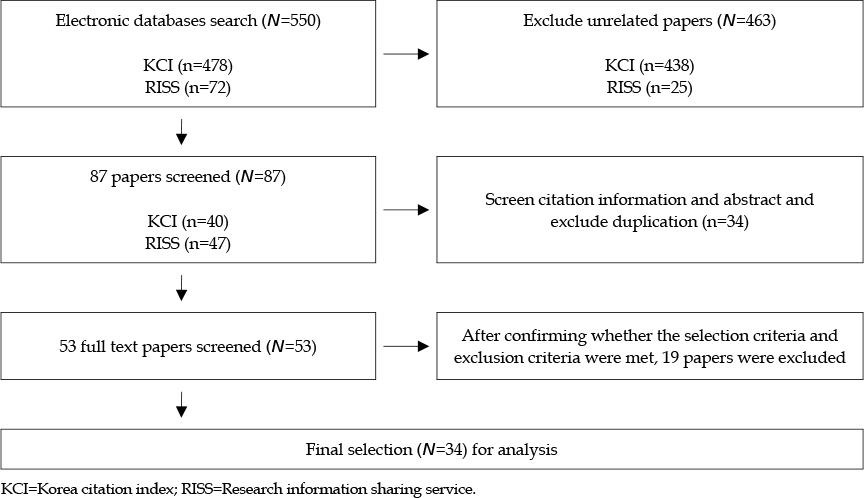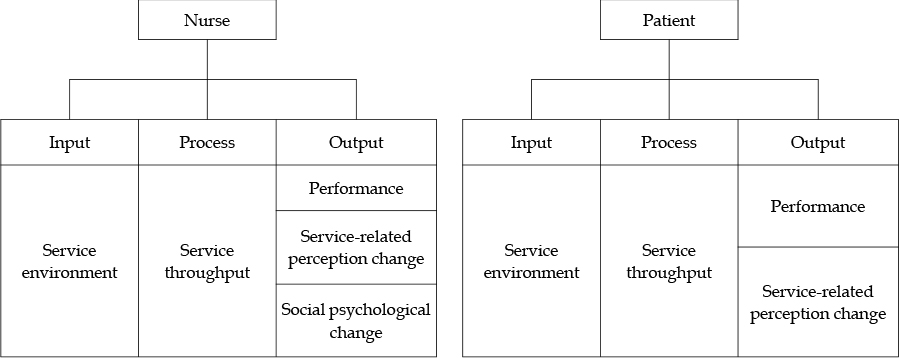J Korean Acad Nurs Adm.
2019 Dec;25(5):510-525. 10.11111/jkana.2019.25.5.510.
The Analysis of Trends in Domestic Nursing Research on Integrated Nursing Care Service
- Affiliations
-
- 1Department of Nursing, Kaya University, Korea. pretty273@hanmail.net
- KMID: 2466938
- DOI: http://doi.org/10.11111/jkana.2019.25.5.510
Abstract
- PURPOSE
The purpose of this study was to explore and analyze the latest trends in domestic research related to integrated nursing care service and to present a practical direction for future research.
METHODS
This study was focused on domestic nursing research related to integrated nursing care service as published in journals until March 20, 2019. After reviewing the quality of the papers, 34 papers were finally selected for analysis. In order to analyze the overall trends, the analysis was reviewed by year, source, research design, and subjects, and content analysis was used to identify trends by topic.
RESULTS
From the content analysis, the top categories were divided into nurses' view and patients' view, with both nurses' view and patients' view for the subcategories of "˜input', "˜process' and "˜output' respectively. From both the nurse and patient view, the sub-category "˜input' included "˜service environment', "˜process' and "˜service throughput' and for the "˜output' subcategory, three subjects, "˜performance', "˜service-related perception change' and "˜social psychological change' were derived from the nurses' view, and two subjects "˜performance' and "˜service-related perception change' were derived from the patients' view.
CONCLUSION
In order for future studies to provide practical basic data for stable settlement and improvement of integrated nursing care service, it is necessary to develop and study various aspects without bias, and in a balanced and integrated manner.
MeSH Terms
Figure
Reference
-
1. Ministry of Health and Welfare (KR). Medical Service Act. Act No. 14438, December 20, 2016.2. National Health Insurance Service (KR). National Health Insurance integrated nursing care program Manual. Wonju: National Health Insurance Service;2016.3. Kim J, Kim S, Park E, Jeong S, Lee E. Policy issues and new direction for comprehensive nursing service in the national health insurance. Journal of Korean Academy of Nursing Administration. 2017; 23(3):312–322. DOI: 10.11111/jkana.2017.23.3.312.4. National Health Insurance Service. Policy direction of comprehensive nursing care [Internet]. updated September 1, 2016. cited April 14, 2017. Available from: http://www.nhis.or.kr/bbs7/boards/B0040/21012.5. Kim MJ, Choi MN, Youm YS. Semantic network analysis of online news and social media text related to comprehensive nursing care service. Journal of Korean Academy of Nursing. 2017; 47(6):806–816. DOI: 10.4040/jkan.2017.47.6.806.6. Cho SH, Song KJ, Park IS, Kim YH, Kim MS, Gong DH, et al. Development of staffing levels for nursing personnel to provide inpatients with integrated nursing care. Journal of Korean Academy of Nursing Administration. 2017; 23(2):211–222. DOI: 10.11111/jkana.2017.23.2.211.7. Park BK, Boo EH, Lee CH, Ahn KH, Yoon HS, Hong NS, et al. Report on monitoring and evaluation of comprehensive nursing care. Research Report, vol 2016-20-022. Goyang, Korea: National Health Insurance Service Ilsan Hospital;2016.8. Boo EH, Ahn KH, Park BK, Hong NS, Son JL, Park MH, et al. Service outcome of comprehensive nursing care and policy direction. Goyang, Korea: NHIS Ilsan Hospital, Institute of Health Insurance & Clinical Research;2015.9. Moon HK, Oh DN, Lee HY. A systematic study on nursingrelated variables of comprehensive nursing care. Asia-Pacific Journal of Multimedia Services Convergent with Art, Humanities, and Sociology. 2018; 8(12):503–511. DOI: 10.21742/AJMAHS.2018.12.04.10. Whittemore R, Knafl K. The integrative review: Updated methodology. Journal of Advanced Nursing. 2005; 52(5):546–551. DOI: 10.1111/j.1365-2648.2005.03621.x.11. Park KO, Park SH, Yu M. Review of research on nursing organizational culture in Korea. Journal of the Korea Contents Association. 2014; 14(2):387–395. DOI: 10.5392/JKCA.2014.14.02.387.12. Choi HJ, Jung KI. The analysis of trends in domestic research on career development of nurses. Journal of the Korea Academia-Industrial cooperation Society. 2018; 19(3):325–336. DOI: 10.5762/KAIS.2018.19.3.325.13. Heo EJ, Jung MS. Analysis of research trends in Korean medical and nursing service marketing. Journal of Korean Academy of Nursing Administration. 2018; 24(4):352–363. DOI: 10.11111/jkana.2018.24.4.352.14. Lee HK, Yang YH, Gu MY, EY . Introduction to Nursing Research. 5th ed. Seoul: Hyunmoonsa;2014. p. 128–136.15. Krippendorf K. Content Analysis: An introduction to its methodology. Newburry Park, CA: Sage;1980. p. 128–136.16. Choi MS. The analysis of trends in career development research and programs at domestic and abroad [master's thesis]. Yongin: Dankook University;2014. 30–31.17. Gillis DA. Management: A Systems Approach. 3rd ed. Philadelphia: W. B. Saunders Company;1994. p. 9.18. Choi HJ, Han AL, Park YM, Lee JH, Tae YS. Hospitalization experience of patients admitted to nursing care integrated service wards in small and medium-size general hospitals. Journal of Korean Academy of Nursing Administration. 2018; 24(5):396–409. DOI: 10.11111/jkana.2018.24.5.396.19. Park KO, Yu M, Kim JK. Experience of nurses participating in comprehensive nursing care. Journal of Korean Academy of Nursing Administration. 2017; 23(1):76–89. DOI: 10.11111/jkana.2017.23.1.76.20. Jung YA, Sung KM. A comparison of patients' nursing service satisfaction, hospital commitment and revisit intention between general care unit and comprehensive nursing care unit. Journal of Korean Academy of Nursing Administration. 2018; 24(1):30–39. DOI: 10.11111/jkana.2018.24.1.30.21. Shin SR, Park KY. Comparing satisfaction with nursing care and factors relevant to hospital revisit intent among hospitalized patients in comprehensive nursing care units and general care units. Journal of Korean Academy of Nursing Administration. 2015; 21(5):469–479. DOI: 10.11111/jkana.2015.21.5.469.22. Choi HJ, Koh MS. Comparative study between the patients' satisfaction level of nursing service and revisiting intention of the inpatients according to the wards type. Health and Social Science. 2014; 37:49–64.23. Yoon JA, Lee HJ. Internal marketing, job stress, organizational commitment and turnover intention in nursing organization. Journal of Korean Academy of Nursing Administration. 2007; 13(3):293–301.24. von Elm E, Altman DG, Egger M, Pocock SJ, Gøtzsche PC, Vandenbroucke JP, et al. The strengthening the reporting of observational studies in epidemiology (STROBE) statement: Guidelines for reporting observational studies. Annals of Internal Medicine. 2007; 147(8):573–577. DOI: 10.7326/0003-4819-147-8-200710160-0001.
- Full Text Links
- Actions
-
Cited
- CITED
-
- Close
- Share
- Similar articles
-
- A Literature Review of Research on Medical Service Design in Korea
- Research Trends in Korea on Integrated Nursing Care Service: A Scoping Review
- Transcultural Nursing: Current Trends in Theoretical Works
- Analysis of Research Trends in Korean Medical and Nursing Service Marketing
- A Comparative Study on Trust, Collaboration and Teamwork of Other Healthcare Personnel by Nurses Working on Integrated Nursing Care Service Wards versus Nurses on General Wards



